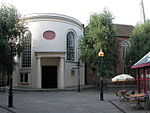Greyfriars, Worcester
Buildings and structures in Worcester, EnglandDefunct schools in WorcestershireGrade I listed buildings in WorcestershireHistory of Worcester, EnglandSchools in Worcester, England

Greyfriars, Worcester is a Grade I listed building in Worcester, England. Its location near to a former friary of the Franciscan order of Greyfriars has in the past led to speculation that it was constructed as their guest house, but it is now believed to have been built as a house and brew-house c.1485 for Thomas Grene, brewer and High Bailiff of Worcester from 1493-1497. It has been in the ownership of the National Trust since 1966.
Excerpt from the Wikipedia article Greyfriars, Worcester (License: CC BY-SA 3.0, Authors, Images).Greyfriars, Worcester
Friar Street, Worcester, England Red Hill
Geographical coordinates (GPS) Address External links Nearby Places Show on map
Geographical coordinates (GPS)
| Latitude | Longitude |
|---|---|
| N 52.190473 ° | E -2.219013 ° |
Address
Greyfriars
Friar Street
WR1 2LZ Worcester, England, Red Hill
England, United Kingdom
Open on Google Maps









